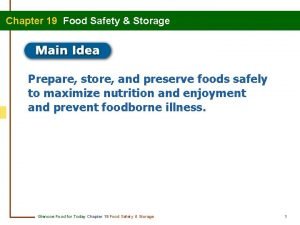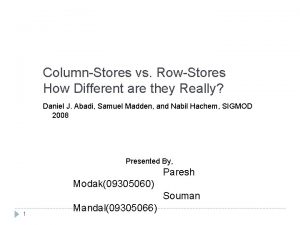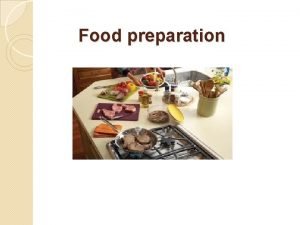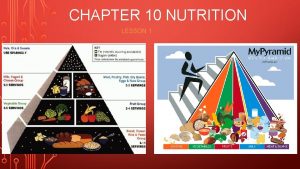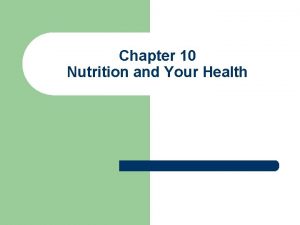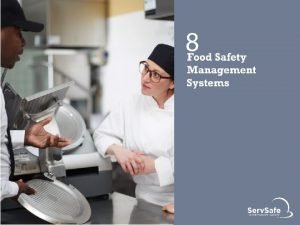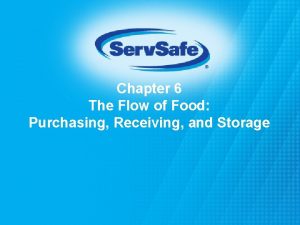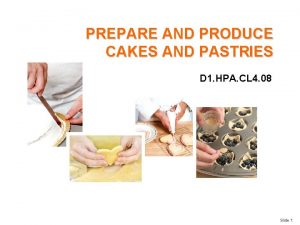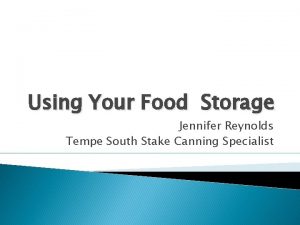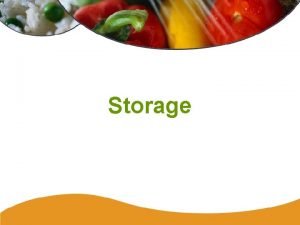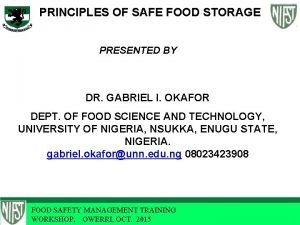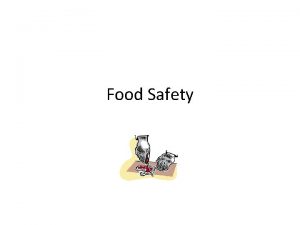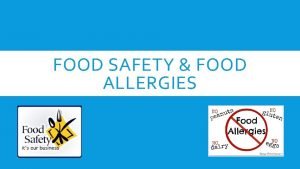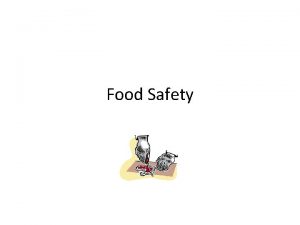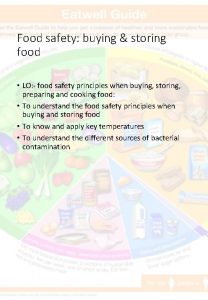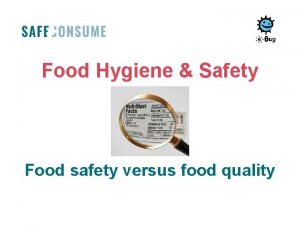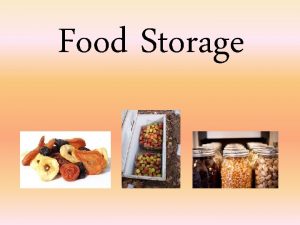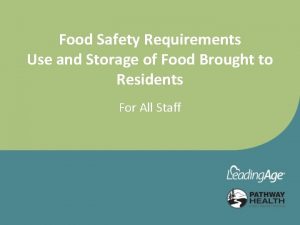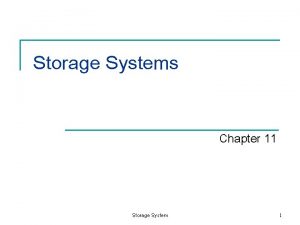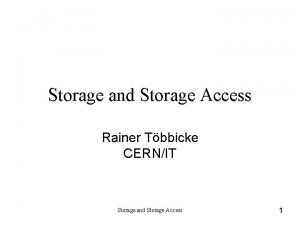Chapter 19 Food Safety Storage Prepare store and























- Slides: 23

Chapter 19 Food Safety & Storage Prepare, store, and preserve foods safely to maximize nutrition and enjoyment and prevent foodborne illness. Glencoe Food for Today Chapter 19 Food Safety & Storage 1

Chapter 19 Food Safety & Storage Content Vocabulary Academic Vocabulary contaminant 20 -second scrub tolerate foodborne illness cross-contamination reserve microorganism internal temperature toxin rancidity spore freezer burn food safety preserve sanitation sugar-pack method personal hygiene Glencoe Food for Today Chapter 19 Food Safety & Storage 2

Chapter 19 Food Safety & Storage Content Vocabulary syrup-pack method boiling-water bath tray-pack method pressure canning dry-pack method rehydrate blanching GRAS list headspace irradiation raw-pack method recall hot-pack method tolerance Glencoe Food for Today Chapter 19 Food Safety & Storage 3

Chapter 19 Food Safety & Storage Foodborne Illness • Contaminants can make food unsafe and result in sickness. contaminants A substance, such as a chemical or organism, that makes food unsafe to eat. Glencoe Food for Today Chapter 19 Food Safety & Storage 4

Chapter 19 Food Safety & Storage Foodborne Illness • Contamination can be caused by bacteria and can be prevented by proper handling and cooking. foodborne illness Sickness caused by eating food that contains a contaminant. Glencoe Food for Today Chapter 19 Food Safety & Storage 5

Chapter 19 Food Safety & Storage Cleanliness in the Kitchen • Cleanliness keeps food safe and the kitchen pleasant. • Keeping your hands clean is the single most effective way to prevent the transfer of bacteria. Glencoe Food for Today Chapter 19 Food Safety & Storage 6

Chapter 19 Food Safety & Storage Cleanliness in the Kitchen Ways to keep your kitchen clean and limit bacteria: 1. Wash work surfaces and utensils in hot, soapy water 2. Wash the tops of cans before opening 3. Change dishtowels often and use new ones daily 4. Wash sponges in the dishwasher or by hand daily 5. Keep pets out of kitchen Glencoe Food for Today Chapter 19 Food Safety & Storage 7

Chapter 19 Food Safety & Storage Cleanliness in the Kitchen • Clean kitchen practices include keeping insects under control, cleaning up after cooking, and avoiding cross-contamination The spread of harmful bacteria from one food to another. Glencoe Food for Today Chapter 19 Food Safety & Storage 8

Chapter 19 Food Safety & Storage Cleanliness in the Kitchen • Ways to prevent cross-contamination 1. Wash surfaces touched by raw meat, poultry, or seafood with hot, soapy water 2. Thoroughly wash cutting boards 3. Keep raw meat, poultry, seafood, and eggs separate from other foods Glencoe Food for Today Chapter 19 Food Safety & Storage 9

Chapter 19 Food Safety & Storage Cooking Food Safely • Food safety guidelines to follow when cooking: 1. Taste only fully cooked foods from animal sources 2. Do not partially cook these foods and finish cooking later 3. Stir and rotate foods when microwaving 4. Reheat foods to 165 degrees within 2 hours to destroy bacteria Glencoe Food for Today Chapter 19 Food Safety & Storage 10

Chapter 19 Food Safety & Storage Cooking Food Safely • Leave food at room temperature only for very short periods. • Check food’s internal temperature to determine if it has been cooked long enough to kill bacteria. internal temperature The temperature deep inside thickest part of the food. Glencoe Food for Today Chapter 19 Food Safety & Storage 11

Chapter 19 Food Safety & Storage Cooking Food Safely • Defrosting food at room temperature allows bacteria to grow. • Keep hot food hot and cold food cold until served. How do you know when meat and poultry have been cooked thoroughly enough to kill bacteria? Glencoe Food for Today Chapter 19 Food Safety & Storage 12

Chapter 19 Food Safety & Storage Temperature Danger Zone Glencoe Food for Today Chapter 19 Food Safety & Storage 13

Chapter 19 Food Safety & Storage Storing Food Safely • Improperly stored food can spoil or lose quality. • Food can spoil due to: • moisture. • heat. • dirt. • dry air. • light. Glencoe Food for Today Chapter 19 Food Safety & Storage 14

Chapter 19 Food Safety & Storage Storing Food Safely • Spoiled food may smell bad, or have mold, bulges, or cloudy fluids. What should you do if you think food is spoiled? Glencoe Food for Today Chapter 19 Food Safety & Storage 15

Chapter 19 Food Safety & Storage Storing Food Safety • Ways to protect the quality of stored food: 1. Buy only what you need 2. Follow package directions for storing 3. Store newly purchased food behind older food 4. Keep track of purchase dates 5. Clean out storage areas periodically Glencoe Food for Today Chapter 19 Food Safety & Storage 16

Chapter 19 Food Safety & Storage Storing Food Safely • To store food at room temperature: • Storage cabinets should be clean and dry – With doors to keep out light, dirt, and pests • Away from heat sources • Away from household chemicals Glencoe Food for Today Chapter 19 Food Safety & Storage 17

Chapter 19 Food Safety & Storage Storing Food Safely • Storing leftovers: • Tightly closed, shallow containers • Refrigerated or frozen promptly Glencoe Food for Today Chapter 19 Food Safety & Storage 18

Chapter 19 Food Safety & Storage Storing Food Safely • Freezer Storage • Fairly full freezer works best – Items act like ice blocks • To prevent freezer burn – Pack foods in airtight, moisture resistant containers Glencoe Food for Today Chapter 19 Food Safety & Storage 19

Chapter 19 Food Safety & Storage Preserving Food Safely • Preserving food by canning, freezing, or drying allows people to save money and enjoy seasonal food year-round. • Canning requires special equipment. self-esteem The feeling that you are a worthwhile, capable person. Glencoe Food for Today Chapter 19 Food Safety & Storage 20

Chapter 19 Food Safety & Storage Preserving Food Safely • Pickling and drying are methods for preserving foods. preserve To prepare food in a way that allows it to be safely stored for later use. Glencoe Food for Today Chapter 19 Food Safety & Storage 21

Chapter 19 Food Safety & Storage Chapter Summary • Proper food safety and storage prevents foodborne illness. • Practicing personal hygiene, maintaining kitchen cleanliness routines, cleaning up properly, and avoiding cross-contamination are all ways to keep a clean kitchen and ensure food safety. • Cook, thaw, and serve food properly and at the right temperature. Glencoe Food for Today Chapter 19 Food Safety & Storage 22

Chapter 19 Food Safety & Storage Chapter Summary • Store food correctly and prevent spoilage. • Preserve food safely by freezing, canning, pickling, or drying. • Government organizations inspect food, prevent diseases, and safeguard the food production process. Glencoe Food for Today Chapter 19 Food Safety & Storage 23
 Chapter 19 food safety and storage activity 1 answers
Chapter 19 food safety and storage activity 1 answers Row store vs column store
Row store vs column store Row store vs column store
Row store vs column store Shielded storage store
Shielded storage store Secondary storage vs primary storage
Secondary storage vs primary storage Secondary storage vs primary storage
Secondary storage vs primary storage Culinary preparations meaning
Culinary preparations meaning What is food safety
What is food safety Chapter 10 lesson 4 nutrition labels and food safety
Chapter 10 lesson 4 nutrition labels and food safety Chapter 10 lesson 4 nutrition labels and food safety
Chapter 10 lesson 4 nutrition labels and food safety Secondary storage provides temporary or volatile storage
Secondary storage provides temporary or volatile storage Unified storage vs traditional storage
Unified storage vs traditional storage Unit 2 food food food
Unit 2 food food food Food chain sequence
Food chain sequence A way to prevent materials handling hazards is to ___.
A way to prevent materials handling hazards is to ___. Food safety management systems servsafe chapter 8 notes
Food safety management systems servsafe chapter 8 notes A grocery store is selling 6 cans of cat food for $3
A grocery store is selling 6 cans of cat food for $3 The flow of food purchasing receiving and storage
The flow of food purchasing receiving and storage The flow of food purchasing receiving and storage
The flow of food purchasing receiving and storage Prepare and produce cakes and pastries
Prepare and produce cakes and pastries Lds church food storage center
Lds church food storage center Types of dry storage
Types of dry storage 5 principles of safe food storage
5 principles of safe food storage Flow of food storage
Flow of food storage
